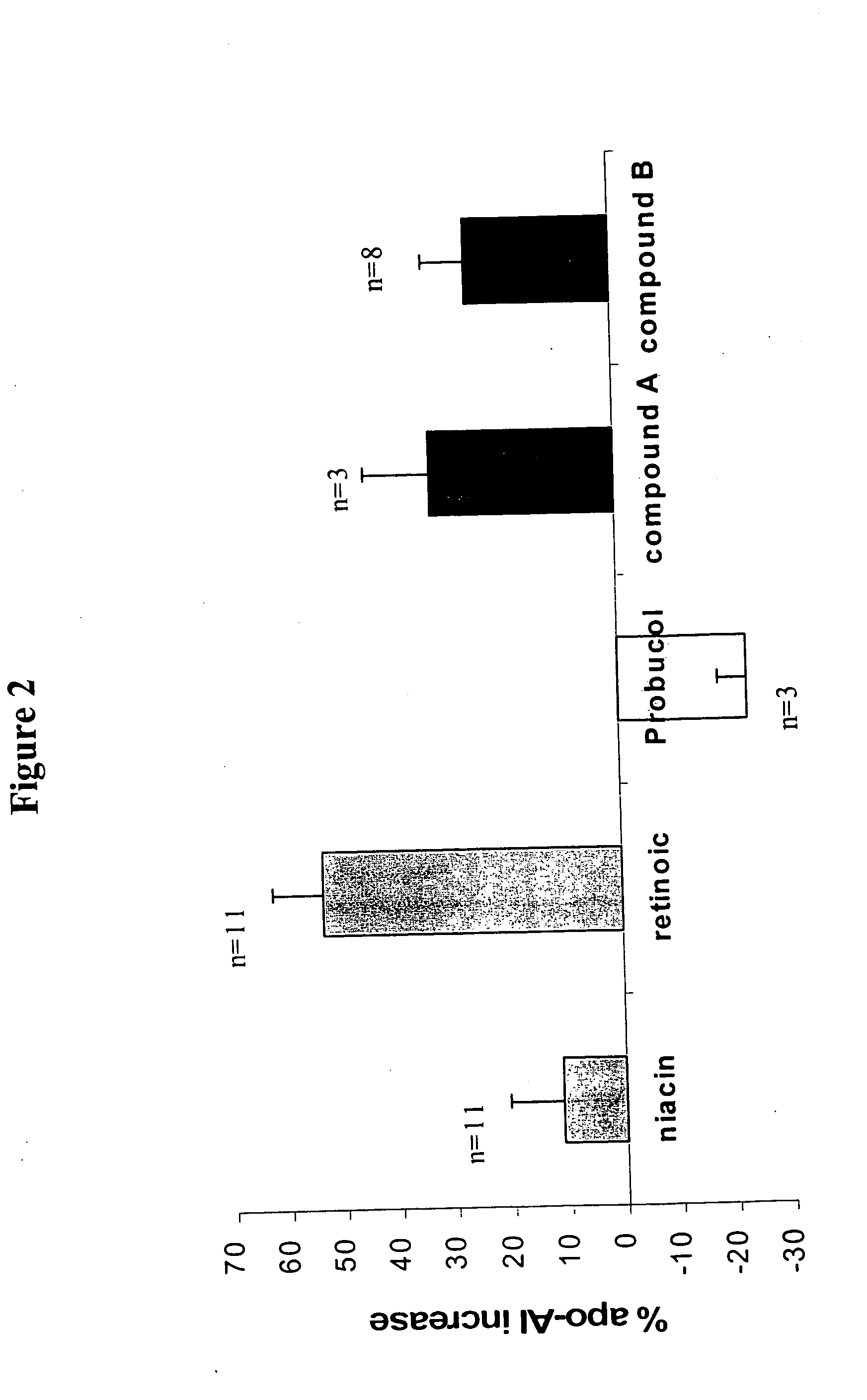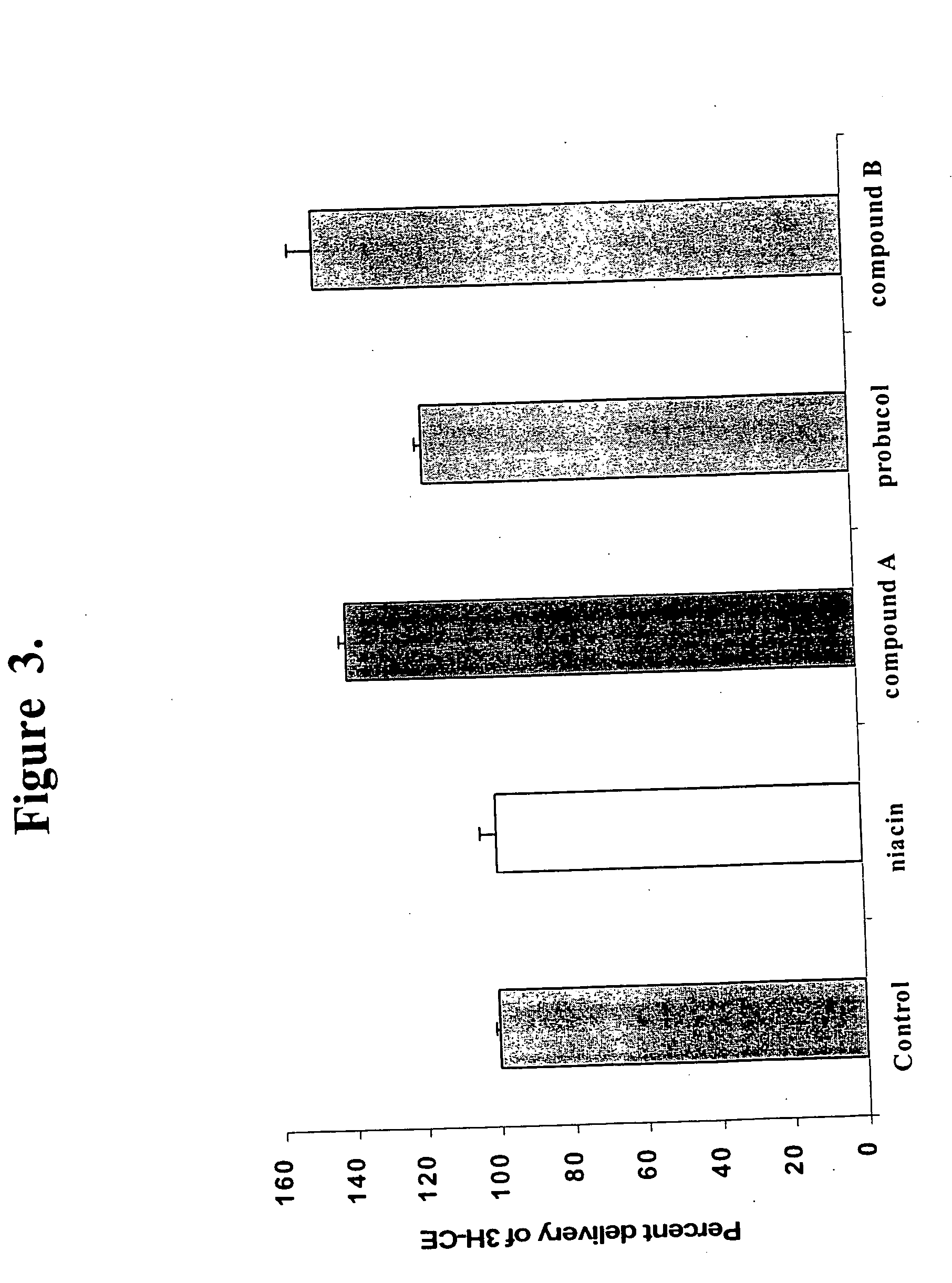Methods to increase plasma HDL cholesterol levels and improve HDL functionality with probucol monoesters
a technology of hdl cholesterol and plasma, applied in the field of coronary heart disease, can solve the problems of limiting chronic use, ischaemia or infarction, and small hdl particles which are susceptible to renal filtration and degradation,
- Summary
- Abstract
- Description
- Claims
- Application Information
AI Technical Summary
Benefits of technology
Problems solved by technology
Method used
Image
Examples
example 1
Pentanedioic acid, mono[4-[[1-[[3,5-bis(1,1-dimethylethyl)-4-hydroxyphenyl]thio]-1-methylethyl]thio]-2,6-bis(1,1-dimethylethyl)phenyl]ester
To a 50 mL recovery flask was added probucol(1.0 g, 1.93 mmol) and tetrahydrofuran (20 mL). To the solution was added 60% sodium hydride in mineral oil (0.16 g, 4 mmol). To the cloudy white mixture was added glutaric anhydride (0.170 g, 3 mmol) in THF(12 mL). The reaction was stirred at room temperature for 3 h. The reaction mixture was made acidic with 1N HCl (25 mL) and extracted twice with ethyl acetate (50 mL). The organic extracts were dried over MgSO4, filtered and concentrated affording a yellow oil. The yellow oil was dissolved in ether and chromatographed on silica gel with a concentration gradient of 70:30 hexane / ether to 0:100 hexane / ether. The appropriate fractions were combined and concentrated affording a white solid. 7.62 (s, 2H), 7.45 (s, 2H), 5.37 (s, 1H), 2.75 (t, Jis7.2 Hz, 2H), 2.55 (t, Jis7.2 Hz, 2H), 2.09 (m, 2H...
example 2
Compound B
4-[4-[1-[[3,5-bis(1,1-dimethylethyl)-4-hydroxyphenyl]thio]-1-methylethyl]-thio-2,6-bis-(1,1-dimethylethyl)phenoxy]-4-oxo-1-butyl sodium sulfate
4-Hydroxybutyrate, [4-[[1-[[3,5-bis(1,1-dimethylethyl)-4-hydroxyphenyl]thio]-1-methylethyl]thio]-2,6-bis(1,1-dimethylethyl)phenyl] (12.5 g, 20.75 mmol) and sulfur trioxide trimethylamine complex (12.5 g, 87.5 mmol) were dissolved in DMF (150 mL) and the mixture was stirred at room temperature for 2 hours. It was then evaporated under vacuum to a residue which was dissolved in dichloromethane (100 mL). The solution was washed with water (2×30 mL) and evaporated. Chromatography (dichloromethane / methanol, 10:1, 5:1) gave 3-[4-[[1-[[3,5-bis(1,1-dimethylethyl)-4-hydroxyphenyl]thio]-1-methylethyl]thio]-2,6-bis(1,1-dimethylethyl)phenoxycarbonyl]propyl hydrogen sulfate.
THF (200 mL) was added to 3-[4-[[1-[[3,5-bis(1,1-dimethylethyl)-4-hydroxyphenyl]thio]-1-methylethyl]thio]-2,6-bis(1,1-dimethylethyl)phenoxycarbonyl]propyl hydrogen sulfa...
example 3
Carboxymethoxyacetic acid, mono[4-[1-[[3,5-bis(1,1-dimethylethyl)-4-hydroxyphenyl]thio]-1-methyl-ethyl]-thio-2,6-bis(1,1-dimethylethyl)phenyl]ester
Probucol (2.63 g, 5.1 mmol) was dissolved in THF (40 mL), sodium hydride (60%, 0.82 g, 20.4 mmol) was added, and the mixture was stirred under nitrogen at room temperature overnight. Diglycolic anhydride (0.71 g, 6.1 mmol) was added and the mixture was stirred for 4 hours. It was quenched with water (5 mL) at 0° C., stirred for 30 minutes, and then poured into 1 N HCl (100 mL). The mixture was extracted with dichloromethane (2×100 mL), dried over sodium sulfate, and evaporated. Chromatography (dichloromethane / methanol, 10:1) gave 77 mg of diglycolic acid, mono[4-[[1-[[3,5-bis(1,1-dimethylethyl)-4-hydroxyphenyl]thio]-1-methylethyl]thio]-2,6-bis(1,1-dimethylethyl)phenyl]ester as an off-white viscous residue.
PUM
| Property | Measurement | Unit |
|---|---|---|
| Electrical conductance | aaaaa | aaaaa |
| Affinity | aaaaa | aaaaa |
Abstract
Description
Claims
Application Information
 Login to View More
Login to View More - R&D
- Intellectual Property
- Life Sciences
- Materials
- Tech Scout
- Unparalleled Data Quality
- Higher Quality Content
- 60% Fewer Hallucinations
Browse by: Latest US Patents, China's latest patents, Technical Efficacy Thesaurus, Application Domain, Technology Topic, Popular Technical Reports.
© 2025 PatSnap. All rights reserved.Legal|Privacy policy|Modern Slavery Act Transparency Statement|Sitemap|About US| Contact US: help@patsnap.com



